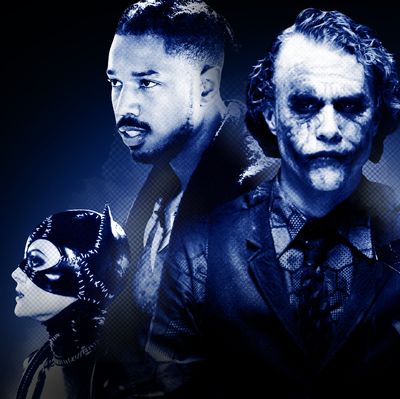
It took a surprisingly long time for the first superhero to meet the first supervillain. In 1938, Action Comics No. 1 launched the superhero genre by introducing Superman and pitting him against … the abstract concept of malfeasance in the criminal justice system (he delivered a signed confession that exonerated a woman about to be executed for murder). For the next dozen issues, he faced petty criminals. Only in 1938 did Superman finally meet a foe truly worthy of his time: the mad scientist known as the Ultra-Humanite. Clad in a distinctive outfit (a white one-piece that evoked both a doctor’s coat and a ball gown), prone to arrogant monologuing, and bent on conquering the world, he began a proud tradition of over-the-top antagonism.
These days, superhero fiction still thrives in the four-color page, but far more people find their tales of costumed adventuring on the silver screen. The genre is unstoppable at the box office, and it wouldn’t have gotten as big as it is today without solid supervillainy. Marvel Studios’ Black Panther just introduced one of the best of the best in Michael B. Jordan’s Erik Killmonger, and we felt the time was ripe to see how where he fits in the ultra-baddie canon. We proudly present to you a definitive list of the 25 best movie supervillains of all time.
Our stipulations were as follows: Each character had to be one of the primary antagonists in a superhero movie (meaning we didn’t include larger-than-life villains in non-superhero movies, e.g., Hannibal Lecter) that had a theatrical release (sorry to all the straight-to-video releases and TV movies out there). In searching for our winners, we generally looked at three criteria that are essential to top-flight mega-nasties. The great ones are visually interesting — that doesn’t necessarily mean a costume, just character design that leaves an impression and expresses what the person is all about. They also have to be remarkable in the screenplay — they usually reflect something relevant back at their respective heroes and have a clever (and at least somewhat intelligible, which is all too rare) master plan. And finally, they have to be played by actors who know how to light up the screen. There are quite a lot of generic Big Bads out there, but the finest ones are often even more exquisite than the folks we’re supposed to be rooting for. Let’s go into the secret lair, shall we?
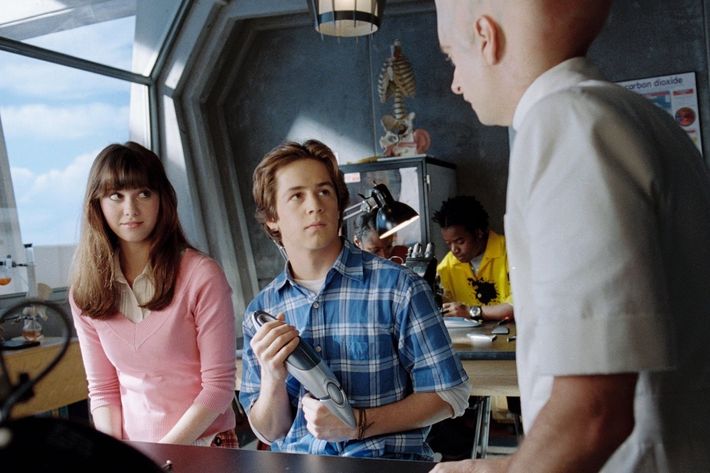
25. Gwen Grayson / Royal Pain (Mary Elizabeth Winstead) — Sky High
The charming teen flick Sky High is the most unjustly overlooked work of our two-decade-old superhero boom. If you’re one of the many who haven’t seen it, you should probably forget you even saw this entry, as it spoils the big twist. But it’s more important to praise the film than protect it from spoilers, so let us offer accolades to the great Mary Elizabeth Winstead, who turned in a great villain performance before she became the sought-after supporting actor she is today. Gwen Grayson appears at first to be a stereotypical teenage love interest for the adolescent protagonist, and she does the best she can with that early material, but once she reveals herself as the film’s grudge-bearing antagonist, the magic begins. Winstead wears grievances with the best of them, growling and scowling her way into your heart, and it’s exciting to see the movie subvert your expectations about what an actress like her can do in a picture like this.
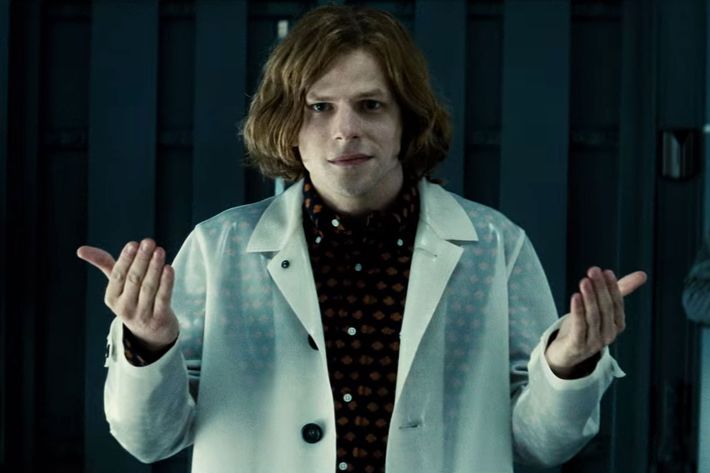
24. Lex Luthor (Jesse Eisenberg) — Batman v Superman: Dawn of Justice
When Warner Bros. announced that Jesse Eisenberg would be playing Lex Luthor in Batman v Superman: Dawn of Justice, one could’ve been forgiven for assuming it would just be a retread of his performance as Mark Zuckerberg in The Social Network. After all, his Zuck had many of the classic elements of past Lex depictions: insatiable avarice, preternatural calm, eternal condescension, and smugness for days. But Eisenberg and director Zack Snyder chose a different path, one that veered more toward giddy insanity than cool imperiousness. Lex’s plot is nonsensical and his character design lackluster (at least the wig is memorable), but his portrayal is one of the film’s highlights. Unlike your average Big Bad, he has virtually no charisma; indeed, his hornet’s nest of tics and grins is supremely off-putting. In a film that stumbles on so many other points (though not as many as its critics claim), Lex’s ability to provide discomfort is something of a virtue. You really want to see this guy go down, not because you fear a world where he’s in charge, but because you’ve met guys like him before and they drive you nuts.
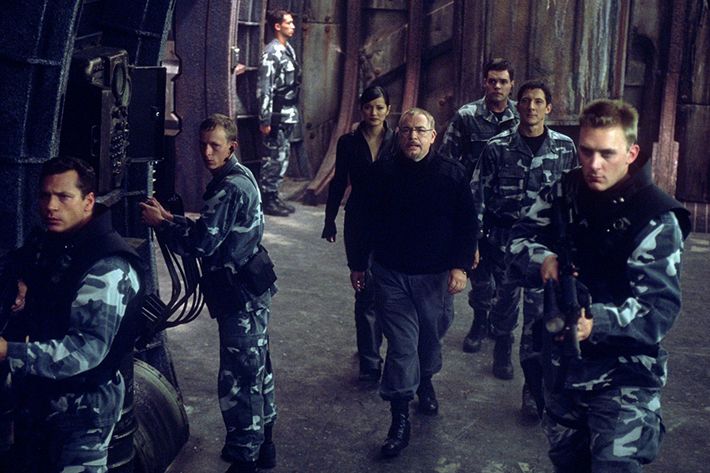
23. Col. Stryker (Brian Cox) — X2
The X-Men have succeeded as a franchise in comics, television, and film in spite of the fact that their antagonists so routinely have the same gist as one another: They’re bigots. Lazy creators routinely give us little reason to be interested in specific anti-mutant crusaders, merely using them as mouthpieces for simplistic prejudice. And then there’s Col. Stryker. Brian Cox and the team behind X2 did as good a job as anyone ever has at crafting a mutant-hater. He’s a stout, plainspoken, Vuhjinyuh-accented black-ops spook, endowed with Cox’s talent for threatening whispers and unsettling half-smiles. We certainly want him to lose, but he’s not motivated by dull bigotry: In a remarkable early scene, Stryker reveals that his son is a mutant with devastating mental abilities who drove poor Mrs. Stryker to a power-drill-induced suicide. Who wouldn’t get a little monomaniacal? Ultimately, we watch Stryker with fascination because he is a perfect, fleshed-out vessel for our suspicion about the biases and tactics of our own government. Mutant superheroes may be an implausible concept, but there is no worse real-life supervillainy than the use of state power against a minority population.
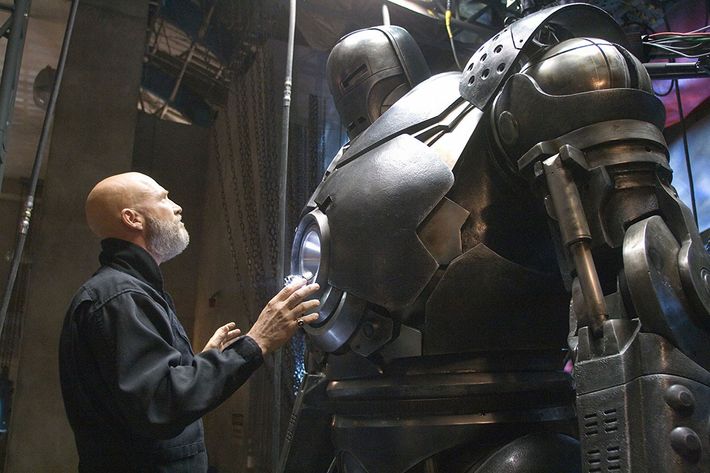
22. Obadiah Stane (Jeff Bridges) — Iron Man
Most elements of Iron Man aren’t anywhere near as good as you thought they were when you saw it in 2008 — with two exceptions. One is the first 16 minutes of the movie, which remains one of the most charismatic stretches in the history of superhero cinema. The other is Jeff Bridges’s turn as avuncular war profiteer Obadiah Stane. With his smoothed pate, giant’s stride, and assertive beard, he cuts a memorable visual presence before he even sets foot into his Iron Monger suit for the concluding tussle. Bridges’s bodily communication is masterful, from his viciously dissective stare to his uncanny ability to somehow seem taller whenever he stoops down at the hip to intimidate someone. One delights in his line readings (“Tony Stark was able to build this in a cave! With a box of scraps!”), but one derives extra joy from Bridges’s defiance of his mainstream pigeonholing as a nice guy. Indeed, his nastiness is often the only thing that keeps the movie afloat during long stretches of thin slapstick and the killing of people of color. We are drawn into his conflict with Tony because Obadiah is a living incarnation of adulthood, telling us that our idealism is misguided and that we need to reconcile with the world, not try to overturn it. He’s probably right on some level, but in a children’s fantasia like this one, it’s nice to see the mean old grown-up get his comeuppance from a (man-)child.
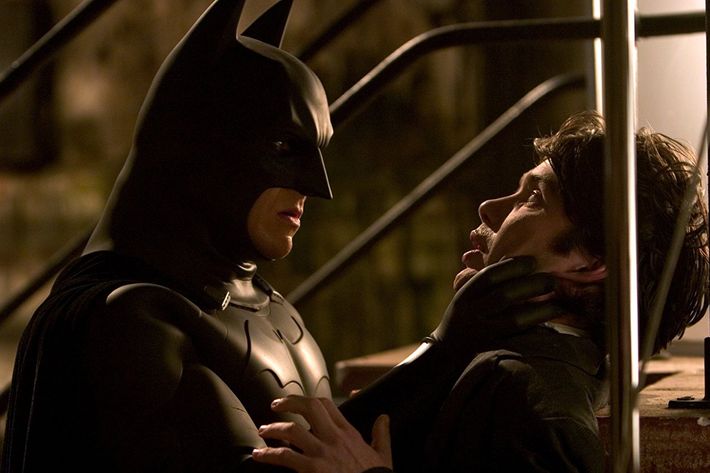
21. Scarecrow (Cillian Murphy) — Batman Begins, The Dark Knight, The Dark Knight Rises
Batman Begins is a top-flight superhero movie, but it doesn’t suffer from being overly subtle. The themes and metaphors are all tapped firmly on the nose, and given that Christopher Nolan and David S. Goyer wanted to explore fear, how could they not include the Scarecrow? He makes a meaty set of appearances in the first installment of the Nolan trilogy, then goes on to cameos in the following two, and he’s always a welcome presence. Cillian Murphy plays this sadistic doctor with unctuous glee, his perverse diagnoses and prognoses dripping from his pouting lips. His aim is delicious: On the one hand, he’s aiding Ra’s al Ghul’s plot to restore order through controlled chaos; but really, he’s just in it so he can get off on seeing a whole city go crazy. We must also give credit to the effects team for devising the visuals that ensue whenever someone is exposed to Scarecrow’s fear toxin, which efficiently capture a panic attack in cinematic form. Murphy is one of the most conventionally beautiful of all of the actors on this list, and that gorgeousness makes him all the more frightening — he brims with the confidence of someone you might go home with (and soon come to regret that you did so).
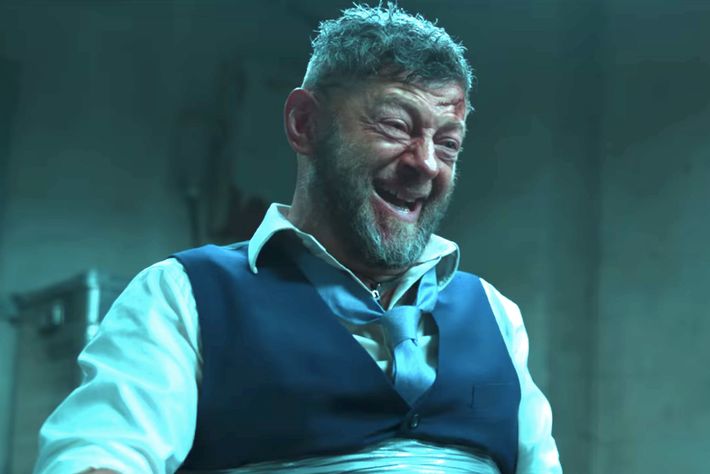
20. Ulysses Klaue (Andy Serkis) — Avengers: Age of Ultron, Black Panther
Any villain can be engaging while reciting a monologue about their plan to subjugate or destroy humanity. It takes a special kind of baddie to grip you while they’re squealing out a rendition of Haddaway’s “What Is Love.” After a brief, forgettable appearance in the generally lackluster Avengers: Age of Ultron, it would’ve been hard to predict that Andy Serkis’s Ulysses Klaue would go on to become one of the most enticing supporting players in the Marvel Cinematic Universe. But that’s just what he did in Black Panther, where he’s one of the two Tolkien White Guys, never quite stealing the spotlight but dancing around like a maniac in its margins. The character design is pleasantly jarring for a couple of reasons. First of all, you’re looking at Serkis outside of a motion-capture context, which is a rarity. Second, he’s frighteningly sexy with his jacked arms, well-tailored shirt/vest combo, and predatory confidence. Serkis wisely chooses to play this South African gunrunner as a cackling, manic contrast to the film’s cooly collected primary antagonist, Erik Killmonger (more on him later, don’t worry), thus offering much-needed amoral glee as a counterweight to the Big Bad’s thematic heft. On top of all that, we have to talk about his vocal delivery. I’m not South African, so I can’t verify whether he nails the accent, but that’s almost beside the point — when he bleats out his lines, he’s concocting a vocal melody, and it’s quite the banger.
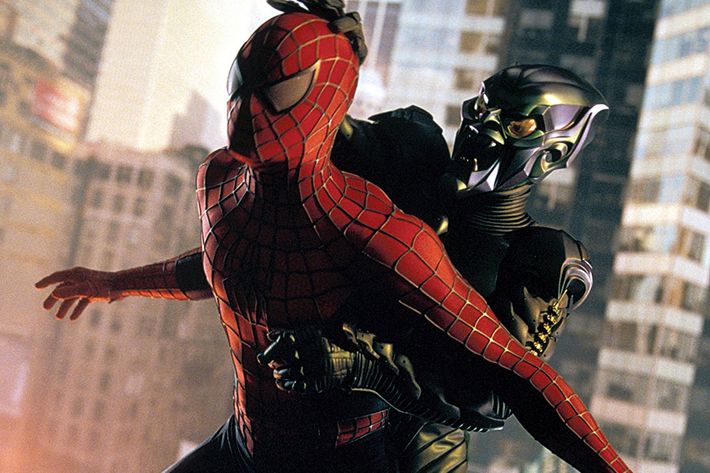
19. Norman Osborn (Willem Dafoe) — Spider-Man, Spider-Man 2, Spider-Man 3
Sam Raimi’s Spider-Man was hailed as a geek godsend when it arrived in 2002 largely because there had been so few good superhero movies, but it feels more than a little dull and formulaic by today’s standards. However, one version of the film never gets old: the YouTube video that removes everything except Willem Dafoe’s dialogue. As Norman Osborn and Norman’s dark alternate personality, the Green Goblin, he turns in one of the all-time hammiest performances in the history of blockbuster cinema, and I mean that as praise. He takes every word and every bit of blocking and wrings them out for every last drop of juice they have. The scene in which he stands before a mirror and talks to himself as both Norman and the demonic Green Goblin is a masterwork, one that’s worth the price of admission for the whole film. The character design for his costume as the high-flying Goblin is dated (no one thinks blocky is sexy anymore), but the visuals are still wonderful, thanks to his intimidating crouch on his ubiquitous hoverboard. His grand scheme to get revenge on those who’ve wronged him isn’t all that interesting on its own, but it’s wild fun to watch Dafoe cackle his way through it.
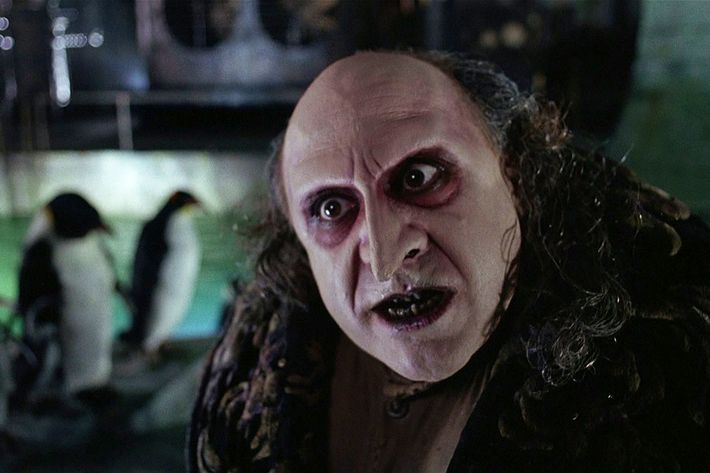
18. The Penguin (Danny DeVito) — Batman Returns
The Tim Burton Batman films are among the most misunderstood in the superhero-movie canon. There’s a popular conception that they’re grim, serious, and mark a definitive break from the campy legacy of the late-’60s Batman TV show. But come on. We’re talking about a duology where Danny DeVito rides a giant rubber ducky and commands an army of rocket-powered penguins. I don’t mean this as a criticism in the slightest: The camp elements of Batman and moreso Batman Returns are masterfully deployed, and nowhere better than in the case of the latter’s Penguin. He is a brilliant inverse of the titular hero. Instead of watching his rich parents die, his rich parents leave him for dead. Instead of growing up coddled and pensive, he grows up deprived and resentful, thus motivating his journey to and from momentary fame and fortune. The character design is appropriately gut-churning and DeVito manages to play the guy as both despicable and pitiable. When those aforementioned penguins carry his corpse into the water like wee little pallbearers, you wish that you could have a little more time with the filthy bugger.
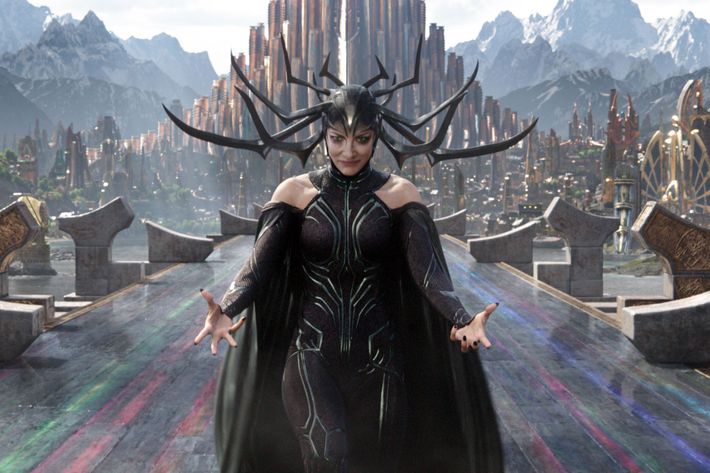
17. Hela (Cate Blanchett) — Thor: Ragnarok
Hela’s appearance in 2017 felt very au courant because she engaged in the all-too-trendy exercise of whataboutism. Over the course of the previous two Thor flicks, we’d been led to believe that the Asgardians were, with the exception of Loki, a largely honorable race of superhumans. Sure, they made mistakes, but they had achieved a kind of utopia in their extradimensional realm of Asgard. Only when Hela shows up do we learn what that utopia was built on: Patriarchal god Odin’s long-ago willingness to destroy and pillage all that stood in his way. You’re calling her violent and reprehensible, Thor? Well, what about your own papa? She is Asgard’s dark history made flesh, and thus a perfect counterweight to the dopey optimism and happy-warrior mind-set of Thor. Beyond that, Hela’s plan and its execution are relatively flat, but we’re never not entertained. For one thing, director Taika Waititi and costume designer Mayes C. Rubeo created one of the all-time great supervillainous looks for Hela, complete with a murderously thrusting headdress and a onesie whose tones are as dark as her soul. But let us bow down before Cate Blanchett, who could thrill us while reading a comic-book price guide but deigns to invest a great deal of energy in her reign of terror. She always sounds refreshed, energized, and in love with herself, like she just took an incredibly luxurious bath. She strides through her every scene with the confidence of a prize Spanish bull, horns and all. When she cackles, the whole Nine Realms cackles with her.
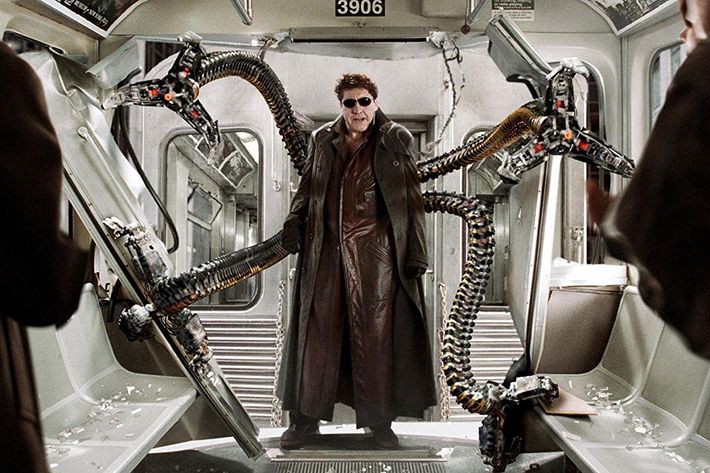
16. Doctor Octopus (Alfred Molina) — Spider-Man 2
If we’re being fully honest, this entry shouldn’t just be credited to Alfred Molina. Spider-Man 2 director Sam Raimi’s practical and CGI effects teams provided at least half the fun of Doctor Octopus by crafting his four robot tentacles. Like pythons granted the power of levitation, they squirm and glide through the air, giving metal form to any number of phallic nightmares. They have character, they provide terror; if this were a list of superhero movie weapons, the arms would be No. 1 with a bullet. But they find a brilliant human assistant in the form of Molina, who grabs his role with an enveloping bear hug. He’s great at shouting about his mad-scientist visions, but the reason we care about him is because we want him to care about us. In his early moments with Peter Parker, he conjures up the platonic ideal of the hard-nosed teacher who sees a spark in you and thus kindles your need for his approval. As such, we see Spidey feel a compelling admiration for his foe and would-be mentor, one that makes the film richer than the average Manichean clash. It’s also worth noting that there have been few supervillains who’ve ever looked like Molina, and there’s a kind of quiet majesty to the vision of this decidedly un-swole man confidently going topless. You do you, Otto.
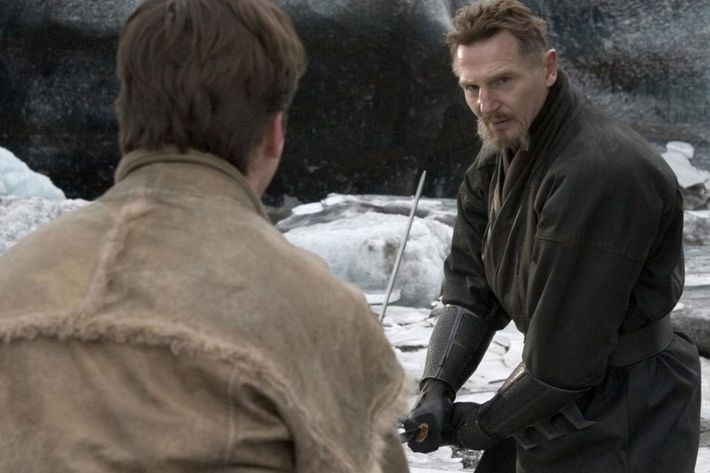
15. Henri Ducard / Ra’s al Ghul (Liam Neeson) — Batman Begins
Lately, I’ve been thinking a lot about printing up T-shirts that declare, “RA’S AL GHUL WAS RIGHT.” The long-standing Batman character’s whole deal is that he believes humanity is a wild animal that has disrupted the natural order and must be brought to heel — and who among us can truly disagree with that diagnosis? In that way, the Batman Begins Big Bad is one of the most sympathetic of all the characters on this list, and that is his greatest thematic and narrative virtue. We can see his point very clearly, both due to David S. Goyer and Christopher Nolan’s gripping script and Liam Neeson’s unsurprisingly flawless turn. It’s hard to determine which Neeson role will have the longest afterlife, but I wouldn’t be surprised if it turns out to be Ra’s, an individual he builds out in sturdy detail. Of particular note is the way he manages to transition from mentor to antagonist without changing a single thing about his performance, thus making us ask whether we can ever trust people with big ideas and motivational demeanors, no matter how appealing they may seem to us at first. Neeson also looks great in his various brutalist warrior outfits, and his goatee deserves its own exhibit in the supervillain hall of fame.
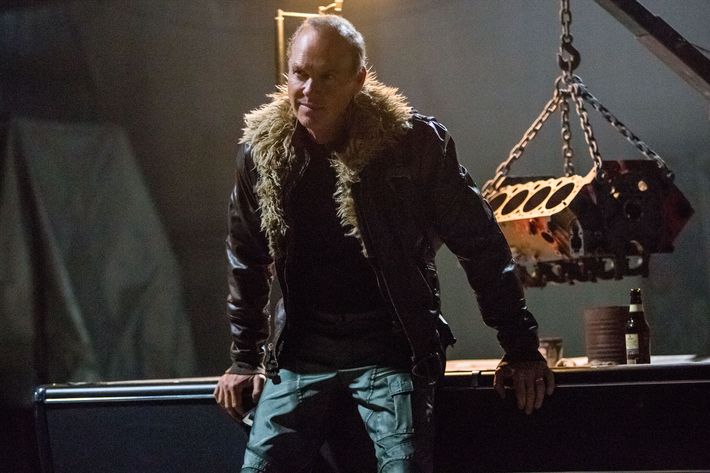
14. The Vulture (Michael Keaton) — Spider-Man: Homecoming
When you’re a teenager, megalomaniacal dictators and universe-destroying superweapons don’t rank high on your list of daily dreads. Quite often, the scariest thing in an adolescent’s world is something common: An angry adult. Although Michael Keaton is a winner in every second of his performance in Spider-Man: Homecoming, he’s most terrifying not when he’s soaring on his deadly metal wings, but rather when he’s calmly threatening Peter Parker in one-on-one conversation. With the help of the film’s six writers and director Jon Watts, Keaton is able to make our stomachs clench in those scenes because we have a bone-deep memory of what it’s like to be condescended to and threatened by a grown-up. And if we look closer, we see in the script another identifiable real-world archetype: the aggrieved nouveau riche douchebag. Vulture used to be a member of the working class until he stumbled across some tech that made him insanely wealthy, and he still thinks of himself as an underdog struggling against elitist oppressors. His resentment knows no bounds, and he thinks his imagined average-Joe status justifies the crimes he commits. He just wants to make the Marvel Cinematic Universe great again, and it’s a cathartic joy to watch him fail at it.
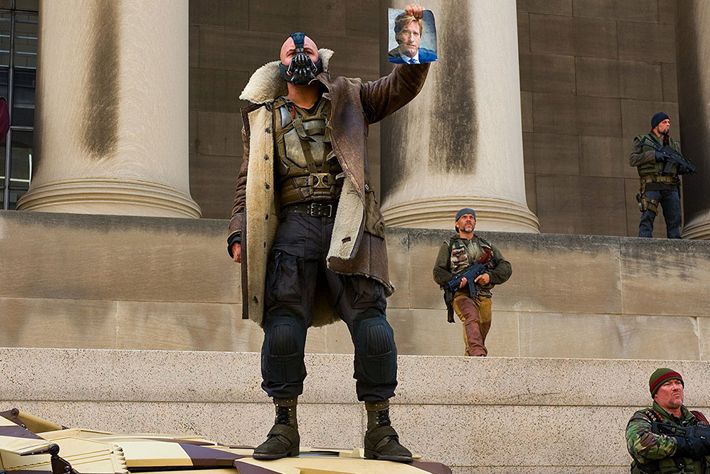
13. Bane (Tom Hardy) — The Dark Knight Rises
Bane’s primary handicap on this list is the incoherence of his plan. He wants to overthrow Gotham’s elites so he can then destroy the city? Because he’s in love? Yes, yes, I know it can be explained by you pedants out there, but one shouldn’t need to pore over a supervillain’s aims like they’re an Aramaic codex. Leaving all that aside, one cannot deny the fact that Tom Hardy, Christopher Nolan, and costume designer Lindy Hemming collaborated to craft one of the most memorable and idiosyncratic supervillain performances of all time. That face! It’s an extreme challenge to make a character compelling when 80 percent of his punim is hidden from view, but Bane’s muzzle was instantly iconic and Hardy’s eye-work masterful. That body! Hardy strutted around with a nimble grace that was mesmerizingly incongruous with his swollen size; same goes for the combo of ’70s-pimp collared coat and brutal black-ops bodywear. And above all: That voice! How on Earth did Hardy construct something so simultaneously melodic and blood-curdling? It all comes together to build out an antagonist for the ages, one who transcends the insufficiencies of his plot.
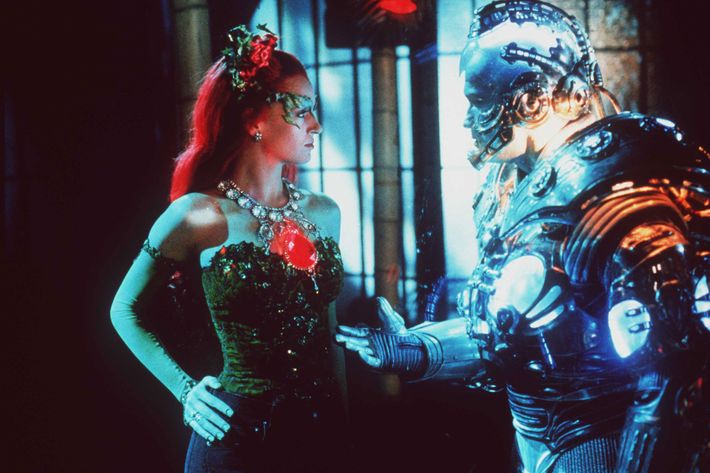
12. Poison Ivy (Uma Thurman) — Batman and Robin
All too often, high-caliber actors cast in supervillain roles opt for camp because they can’t think of anything else to do. But in Batman and Robin, Uma Thurman seems to have opted for camp because she wanted to elevate it to high art. Her performance as plant-themed baddie Poison Ivy is a treasure, executed with such expertly observed artifice that you’d think she was doing a performance-art dissertation on Susan Sontag. Her look would fit right in on RuPaul’s Drag Race, what with its eyeball-scorching green unitard, horn-rimmed eyebrow … things, and hair-growths that look like the Petronas Towers. Thurman adopts a bizarre Old Hollywood accent after she goes through her origin-story accident, and it lends a glory to lines like, “It’s not nice to fool with mutha naychah!” It all works especially well because it’s a perfect fit with the rest of the movie’s over-the-top insanity — only someone like her would make a fitting foil to a man with bat-nipples. In our current age of grim and gritty supertales, a brush with Ivy’s foliage is more antidote than poison.
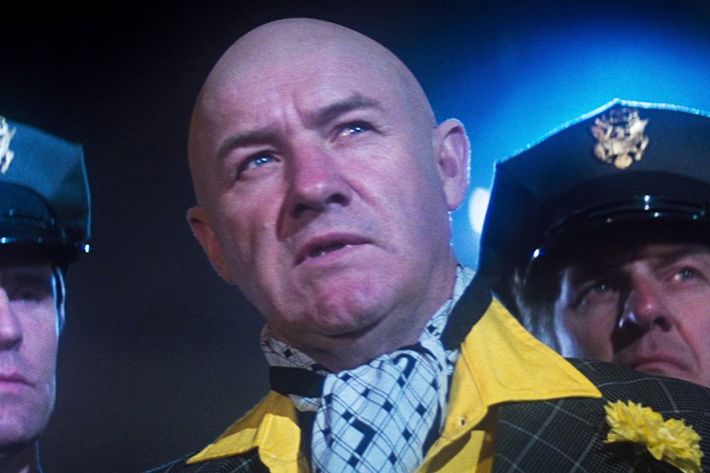
11. Lex Luthor (Gene Hackman) — Superman, Superman II
The Lex Luthor of 1978’s Superman is a throwback, and not just in terms of his flared sleeves and mustard collar. Since a comics reboot in the mid-1980s, the character has usually been portrayed across all mediums as a rapacious but somewhat honorable bajillionaire industrialist. But prior to that, he was just a greedy criminal with a mad-on for Superman, and that’s the approach director Richard Donner, writer Mario Puzo, and Gene Hackman brought to an apogee. He is avarice, hubris, and vanity incarnate; a man whose dreams are at once massive and petty. I mean, come on, his plan is to nuke part of California off the continent so he can sell off real estate in the new West Coast — a plan that makes next to no sense, yet is delightful in its novelty and ridiculousness. His boasts are poetry (e.g., “Some can read War and Peace and come away thinking it’s an adventure story; others can open the wrappers of chewing gum and unlock the secrets of the universe!”). His clownishly foppy fashion sense sears itself into your memory. And Hackman efficiently translates his own obvious disdain for the source material into Luthor’s disdain for anyone and everyone — if yelling at henchpeople and delivering shit-eating grins were Olympic sports, he would’ve medaled twice. At one point, Lex asks, “Doesn’t it give you kind of a shudder of electricity through you to be in the same room with me?” Yes, you magnificent bastard, it does.
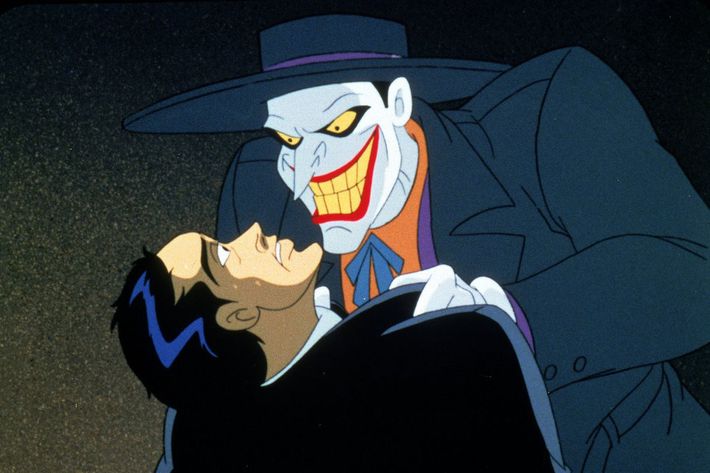
10. The Joker (Mark Hamill) — Batman: Mask of the Phantasm
If this were simply a list of the greatest supervillain performances in any medium at any time, you could make a solid argument that Mark Hamill’s animated Joker would deserve the top spot. Ever since television’s Batman: The Animated Series debuted in 1992, the actor has put in hours upon hours of recorded vocal work as the Clown Prince of Crime, much of it truly stunning. You can’t help but be utterly charmed by this Joker, making it all the more alarming when Hamill and his writers abruptly remind you that he’s a mass murderer. And just seconds later, you’re laughing again, but this time, worrying about what that means about yourself. Hamill’s only theatrical performance as the character was in the underappreciated animated 1993 feature film Batman: Mask of the Phantasm, which keeps him from No. 1 because the script’s Joker elements are a little lackluster. For one thing, we get bits of his backstory, and the clown is always best when he emerges from total mystery. He also has to share the antagonist’s spotlight with other figures, and his villainy isn’t the primary driving force of the narrative, all of which weakens his impact. That said, Hamill still provides thrills every time he graces your speaker with his maniacal voice — a voice that has made the superhero-fiction canon infinitely richer.
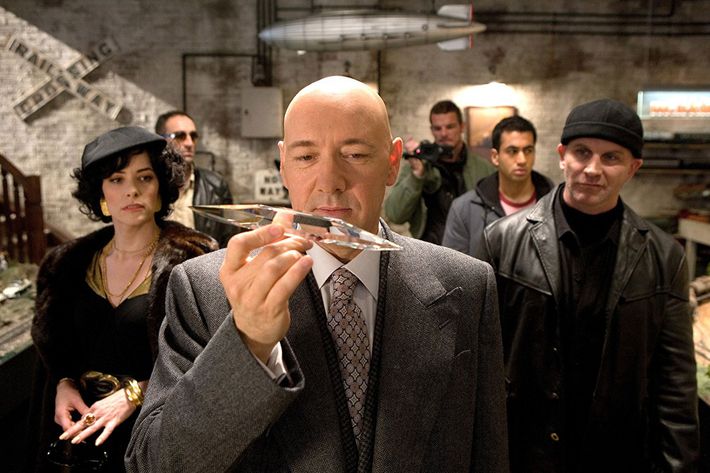
9. Lex Luthor (Kevin Spacey) — Superman Returns
This is, of course, an uncomfortable entry to write. In the years since Superman Returns premiered, a pall has been cast over the film due to the alleged conduct of some of the people behind it. The sexual-assault accusations against Lex Luthor actor Kevin Spacey are horrifying, as are those against director Bryan Singer. They are not to be taken lightly, and it’s entirely justifiable to never watch the film again. Nevertheless, we can praise Michael Dougherty and Dan Harris’s sorely underrated script for its portrayal of Lex as a Superman-hating Übermensch in the Nietzschean sense of the term: a genius human freed from conventional morality who dreams of reshaping the world. His plan — create a new landmass using stolen Kryptonian technology and lord over it — is an intriguing callback to and improvement upon the character’s aim in the 1978 Superman. His exquisite suits and defiantly bald pate are perfect for Luthorian iconography. But one must cautiously admit that the linchpin is Spacey’s thespian mastery. He mixes up a strong brew of confidence, condescension, and fury that, in a time before the current era, made for a thrilling moviegoing experience.
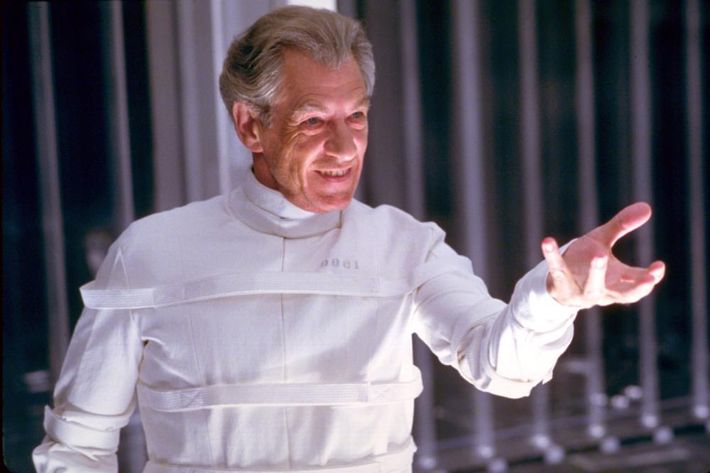
8. Magneto (Ian McKellen) — X-Men, X2, X-Men: The Last Stand, X-Men: Days of Future Past
Whoever was going to get the role of Magneto in the X-Men franchise had a big leg up purely due to the fact that they were playing Magneto. The character is arguably the best villain to ever grace the comics page (his only real competitors are Lex Luthor, the Joker, and Dr. Doom), so as long as the writers did their job and crafted him in a way that was true to his source material, any decent performer would have done just fine. How blessed we are, then, that we were graced with no ordinary player, but with the incomparable Sir Ian. One of the finest Shakespearean players of his generation, McKellen was vastly overqualified for this pulpy part, but throughout his four turns as Erik Lehnsherr, you never feel as though he’s talking down to his audience. With his murderously dour visage and eternally disappointed murmur, McKellen builds us a man who has survived unspeakable trauma and has come to an understandable set of conclusions about how humanity treats that which it fears. As he stares at us, clad in his chillingly sleek robes and helmet (all hail costume designer Louise Mingenbach), we fear him but cannot entirely blame him for what he wants to do to us. It should be noted that Michael Fassbender is also an excellent Mags, but the crafters of his stories have made him too sympathetic and benevolent to ever really qualify as a supervillain. You can argue that the same is true for the McKellen run from X2 onward, but there’s no denying that the Magneto of X-Men is a goose-bump-inducer for the ages.
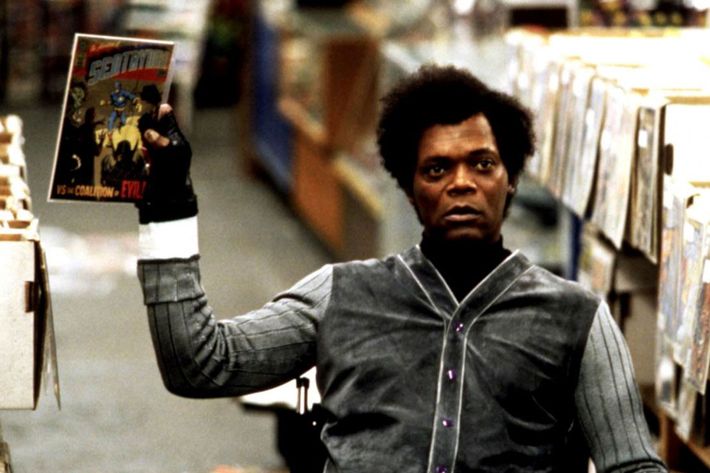
7. Mr. Glass (Samuel L. Jackson) — Unbreakable
M. Night Shyamalan’s Unbreakable is, at its core, a film about discovering who you’ve always been. Along those lines, Samuel L. Jackson’s character is someone whom the angry geeks of the world should pay close attention to. Jackson and Shyamalan together construct Elijah Price as a dark vision of entitled geekdom, one that feels far more relevant today than it did upon the film’s release in 2000. There have always been nerds like Elijah, ones who embrace tales of spandex-clad derring-do a little too tightly and are swift to anger when anyone tries to burst their bubbles of fandom. They want respect, they want the magic of the adventures that dominated their childhood, and damn anyone who stands in their way. Elijah, of course, takes things to an extreme by sparking tragedies in an effort to sift through humanity and find the world’s first superhero — but narcissistic, destructive monomania is rampant among the Gamergate types of the world, and Unbreakable captures it with a unique power. Shyamalan’s stunning realist masterwork first makes us sympathize with the physically fragile Elijah, then forces us to remember that fragility can breed malice. Jackson is a wonder to behold from an aesthetic standpoint, with his westwardly listing hairdo and immaculate deep-purple overcoat, and his acting is as nuanced and tense as it’s ever been. To quote Elijah in his first scene, the one where he reams out a prospective buyer of some comics artwork for wanting to give it to a child, “This is an art gallery, my friend, and this is a piece of art.”
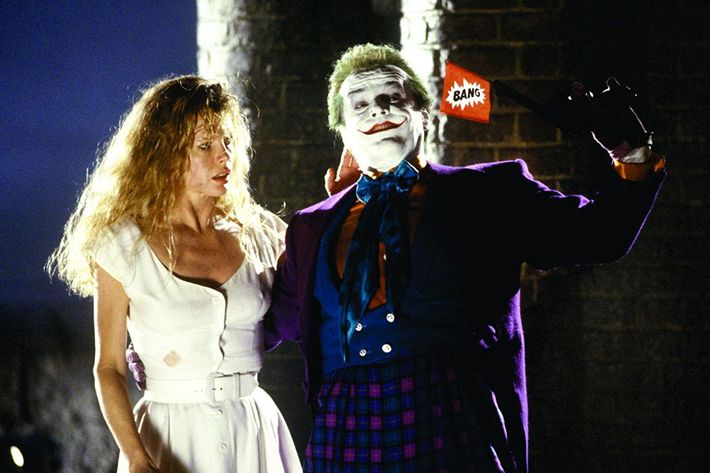
6. The Joker (Jack Nicholson) — Batman
When you take a step back, it’s somewhat insane that we live in a world where you can just straight-up watch a movie where Jack Nicholson plays the Joker. One of the greatest film actors of any generation, a master of grinning menace, donning the lipstick of the Clown Prince of Crime? It’s almost too perfect, isn’t it? As the story goes, Nicholson wasn’t exactly sanguine about taking on the part and had strict stipulations for his participation and demanded generous time off (I mean, think of all the Lakers games he would’ve had to miss otherwise), but thank goodness he decided to slum it. “I am the world’s first fully functioning homicidal artist,” his Joker declares at one point, and boy, he’s not kidding. Tim Burton and screenwriters Sam Hamm and Warren Skaaren chose to make this Joker a performer, first and foremost, doing everything out of a sick desire to make an impression on the public. Nicholson syncs with that notion perfectly, aweing viewers with his confidently perverse exaggerations of human speech and behavior (witness the struts of the art-defacing scene set to Prince’s “Partyman”). And, of course, we would be remiss if we didn’t applaud prosthetic makeup designer Nick Dudman for his construction of that inhuman smile, at once ridiculous and the stuff of nightmares. Get a load of this Joker and you’ll never forget him.
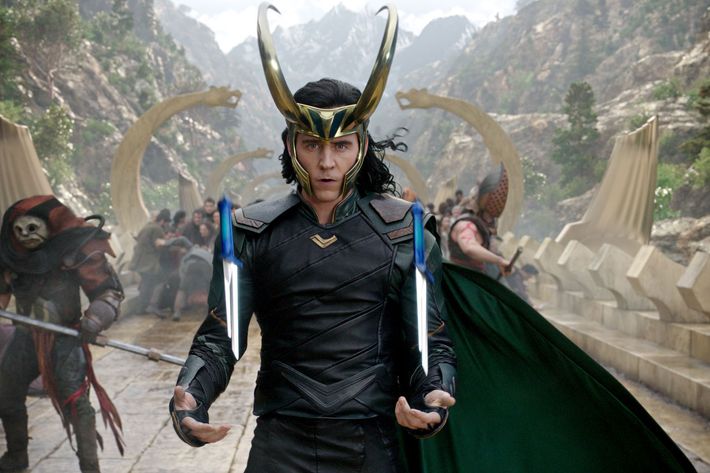
5. Loki (Tom Hiddleston) — Thor, The Avengers, Thor: The Dark World, Thor: Ragnarok
It’s no secret that the Marvel Cinematic Universe has what the geek commentariat refers to as a “villain problem.” It’s a simple problem to explain, and an enormously difficult one to fix: Their bad guys are usually pretty lame. Malekith, Kaecilius, Whiplash, Yellowjacket, the Abomination — for at least one of those, you probably struggled to remember what movie he was even in. Even the decent ones tend to be just that: decent, occasionally fun, and little more. To a certain extent, this isn’t Marvel Studios’ fault, given that they currently don’t have access to the movie rights for Marvel Comics’ greatest baddies: Magneto, Dr. Doom, and Galactus. They’re forced to make do with what they have, but they’ve never done that better than they have with Thor’s oft-estranged brother, Loki.
First appearing in Thor, then popping up prominently in The Avengers, Thor: The Dark World, and the giddy Thor: Ragnarok, Tom Hiddleston’s God of Mischief has become one of the best characters in the MCU, outpacing a great many of its protagonists. Despite being put in the hands of different writers over the years, his spirit has shone clear. We swoon over his stirring combination of scheming hubris, relatable envy, and simmering sensuality. Among the males on this list, only Killmonger comes close to the power of Hiddleston’s curious sex appeal. He’s a perfect inverse of proud, virtuous Thor. The MCU overlords know they have a winner in this guy, so expect him to stick around until his greasy hair turns gray.
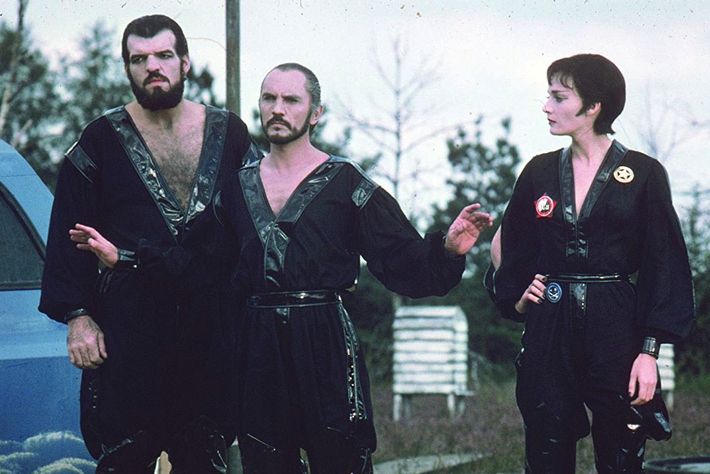
4. General Zod (Terence Stamp) — Superman, Superman II
So much science fiction made by white people is ultimately an expression of guilt about colonialism. Basically every canonized alien-invasion story in the English language turns empire on its ear, asking white readers to imagine what it would be like to be part of an indigenous people murdered or enslaved by outsiders who couldn’t care less about your dignity. And no sci-fi of the superhero variety has embodied this principle more effectively than the Richard Donner cut of Superman II. Specifically, we see the world-historical horror that is the imperial mind-set in the figure of Terence Stamp’s General Zod.
For the reasons listed above, it was entirely crucial that this Kryptonian demigod be played by an Englishman, and the handsome, perpetually scowling Stamp was a choice whose perfection knows few bounds. We first laugh at his haughty condescension and blithe disregard for the lives of the Earth-natives he seeks to conquer, because he seems like he’s just riffing on the Republic Serial villains of old. But there is no wink here, no sense of humor. There is merely the heady cocktail of entitlement and strength. When he arrives unopposed in the Oval Office and casually orders the president to kneel before him, we feel the unspeakable terror of learning that our power structures are worthless before a sufficiently forceful conqueror. “Oh, God,” the president mutters to himself in anguish. The villain corrects him with a single word: “Zod.”
This metaphorical oomph is, consciously or not, why we are drawn to Zod and why this sequel remains the best Superman movie ever made (with the quasi-exception of Brad Bird’s Superman riff The Iron Giant). It’s made all the more effective by Zod’s flowing onesie, which somehow seems just as welcome in Studio 54 as at the Nuremberg Rally. The script offers a plethora of snooty threats that feel like the platonic ideal of this sort of self-involved villain (“Why do you say this to me when you know I will kill you for it?” is a particular favorite). This depiction would be great in any setting, but the key here is his antagonism to Superman, who represents all that privileged people should do with their power. We try to be Superman, but all too often, we empower the Zods of our own world.
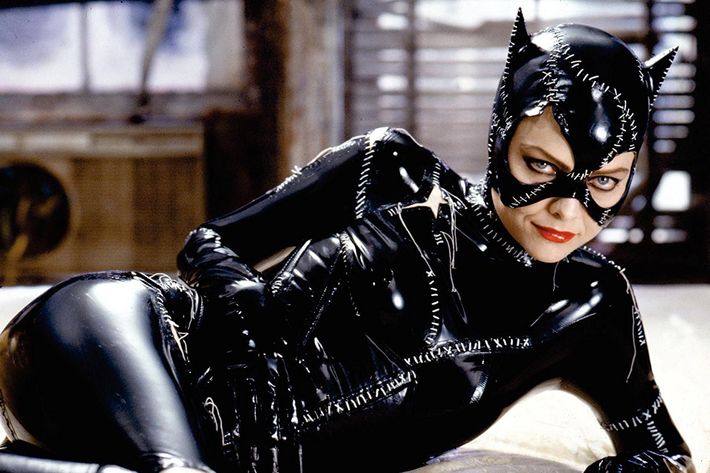
3. Catwoman (Michelle Pfeiffer) — Batman Returns
Before you read this entry, I encourage you to peruse my colleague Angelica Jade Bastién’s essay on the eternal magic of Michelle Pfeiffer’s turn as Catwoman in Batman Returns. Here’s my vain attempt to live up to the high bar set by Angelica. The Cat-Bat relationship is one of the central dynamics in all Batman fiction (indeed, as of this writing, the pair are engaged to be wed within the pages of DC Comics, though one imagines that can’t end well), and with good reason: It’s a troubled romance not between a dashing hero and his adoring lady-love, but between two equal — and equally screwed-up — figures of the night. They kiss, they fight, they debate tactics, and we can never decide whether or not we want them to hang up the spandex and make little vigilante babies together. Some call it love; I call it magic.
You can play Selina Kyle as anti-hero or sympathetic villain, but in this writer’s opinion, she’s always more interesting as the latter, and that’s the choice Tim Burton and his cohort made for her in Batman Returns. Here, Catwoman is nothing short of the return of the repressed. A hard-working, ambitious woman who receives no respect in the workplace or from society at large, she finally snaps and decides to more or less declare war on mankind — emphasis on man. Sure, she dresses up in a dominatrix outfit, but she barely feels male-gaze-y — her stunning look is designed to, well, stun. It’s as much a weapon as her whip and her claws. So are her Daniel Waters–penned lines. To wit: “Life’s a bitch. Now so am I.” When she plays off of Batman, she’s the one in control. If she really wanted to, she could crush him in an instant, but like any cat, she enjoys toying with her prey. Her feminism is a blunt instrument (e.g., “I am Catwoman, hear me roar!”), but blunt instruments, when swung right, leave quite a mark.
All of these elements would be good enough on their own, but they’re elevated from good to great by Pfeiffer’s performance, whose curled-finger confidence is made all the more impactful by her deft portrayal of harried self-loathing at the movie’s start. When Selina cries out of frustration and confusion with an unjust world, Pfeiffer sells it breathlessly, and we want nothing more than for her to succeed, damn the costs. Plus, she put a goddamn bird in her mouth during filming, so just give this woman a lifetime achievement award, already.
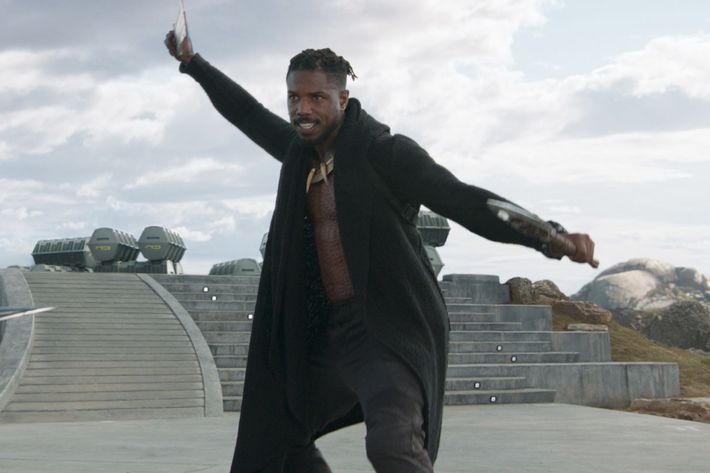
Extremely mild spoiler for Black Panther below.
2. Erik Killmonger (Michael B. Jordan) — Black Panther
The first time we see Erik Killmonger in Ryan Coogler’s stunning Black Panther, we know within a few minutes that we’re dealing with a sort of villain we’ve never seen before in superhero cinema. He’s in a British museum’s West African wing, gazing at the artifacts contained therein. A museum employee walks him through where a few of them are from, and when she gets to a particular axe and says it’s Beninese, he corrects her: No, it’s originally from Wakanda, an unconquered, technologically advanced African nation. A lesser character would have left the description there and stolen it, as is his plan. But no, Erik goes out of his way to point out that it was stolen by the British military from the Beninese; that all of the objects around him are goods stolen in the pursuit of empire at the expense of black people. Oh, and he’s poisoned her. He wants to make sure the last words this cultured and comfortable white person hears are about the legitimate grievances of the people whose oppression she’s benefited from.
Violence and the righteous cri de coeur of the African diaspora: These are the building blocks of Erik Killmonger. In scene after scene, he grabs us by the shoulders, stares directly into our eyes, and tells us we’ve failed black people everywhere. He says this to us whether we are black or not — indeed, throughout the film, we see his ire directed most often toward the Wakandans. Coogler and Joe Robert Cole’s script gives him a red-hot thematic knife to wield against these comfortable Africans in hiding. He tells them they’ve let down their brothers and sisters by allowing oppression around the globe, and they know in their hearts that he’s not all that wrong. His accusation against the world is more convincing, more urgent, than any other on this list. You may not believe he and his proposed global campaign should succeed, but you can’t in good faith argue his underlying assumption. He believes black people have gotten the rawest of deals for centuries, and that point is more or less indisputable.
As the Jews say on Passover: dayenu — that would be enough. But we are also blessed with a performance for the ages from Michael B. Jordan. Clad in Ruth E. Carter’s endlessly sexy, relentlessly intimidating costumes, he swaggers his way into our souls during every scene he’s in. He mostly delivers lines with the refined fury of an actor playing Richard III, but he’s capable of shockingly effective jumps into vernacular English (there’s a point at which he says, “Hey, Auntie” and the audience doesn’t know whether to laugh or shriek). He is written as a veteran of America’s current forever war, and Jordan knows how to subtly convey the trauma-hardened confidence of those who serve. He is truly sui generis. It’s all enough to give you goose bumps for days, and by the time he delivers his astounding last lines, you’ve fallen into a profoundly conflicted love for this man who would hit the reset button on our unequal world.
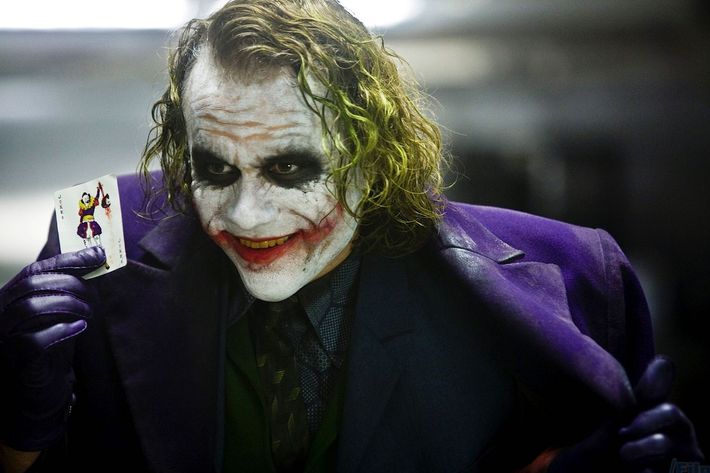
1. The Joker (Heath Ledger) — The Dark Knight
There was a time, not so long ago, when people generally didn’t want to be the Joker. He was the most iconic villain for superhero fiction’s most iconic hero, but he was, at most, someone you might dress up as for Halloween. Then, along came Heath. The late Heath Ledger didn’t just turn in a world-class performance as the Clown Prince of Crime in The Dark Knight (still the only superhero-movie performance to win an Oscar). He changed popular culture. Before the film’s 2008 release, the average person might know who the Joker was; after it, people started carrying the tortured misanthrope around as a perverse patron saint. Before, there were a few memorable Jack Nicholson–era lines associated with the character; after, devotees — many of them otherwise non-geeky — started quoting his dialogue like Maoists reciting from the Little Red Book. There are folks who build their whole life philosophies around the guy now, for better or (usually) for worse.
Which leaves us with a question: Why so serious? You’ll get your answer on your first viewing or your fiftieth. Obsession is a natural response to this once-in-a-lifetime constellation of design, writing, and acting. His Lindy Hemming–designed outfits — that shade of purple on the large coat that still seemed to fit perfectly; that uncomfortably sexy combo of tailored vest and tight pants — were instantly iconic, as was the perfect anarchy of makeup designer Peter Robb-King’s scars and greasepaint. David S. Goyer and the Brothers Nolan penned a story that made Joker a terrifying narrative dynamo, the living embodiment of our suspicion that nothing is fixed into place. Other supervillains threaten us with totalitarian control, but such threats are almost quaint in our present era — the fear of Joker-esque chaos is much more Zeitgeist-y in our crumbling millennium.
And as for Ledger, well, what can you say that hasn’t already been said? The man took all of those aforementioned elements and added in a mixture of menace and humor the likes of which is rarely seen in any genre. I vividly recall how my opening-night crowd nearly vomited with shock at the pencil trick, then burst out in awed laughter just two minutes later when one of the mobsters asks him, “You think you can just steal from us and walk away?” and the bomb-wielding Joker deadpans, “Yeah.” How on earth can an actor elicit those two responses in such close proximity — and in that order? Words fail.
Perhaps the most important lesson to be gleaned from this list is that — as mundane as this statement may be — the Joker is still the greatest supervillain in the canon. He ostensibly has no superpowers, but as comics writer Grant Morrison noted in Arkham Asylum: A Serious House on Serious Earth, he possesses a kind of deranged “super-sanity”: He has few of the filters the rest of us use to make sense of our horrific world, and he’s learned how to adapt to it by refusing to pretend that society is anything other than arbitrary nonsense. In that way, he is — and, again, forgive me for stating the obvious — the perfect foil to his eternal adversary, the order-hammering Batman. Writers are capable of giving him brilliant schemes and memorable words because he lacks limits and embraces absurdity. Fans are seduced by his nihilism because it’s not that far from the truth. Artists can go wild with his instantly recognizable look, cribbed from Paul Leni’s 1928 film The Man Who Laughs but never out of style. To paraphrase The Dark Knight: The Joker is — and always shall be — ahead of the curve. Ha ha ha ha ha.

